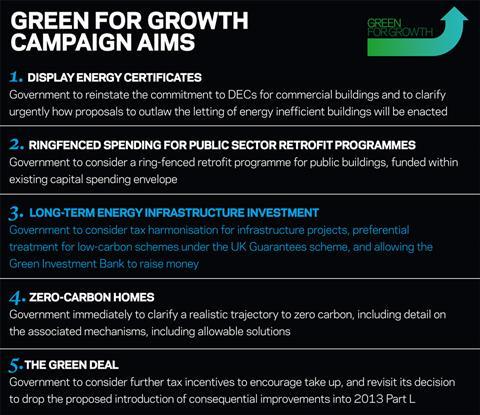The UK’s renewable energy policy compares fairly well to other countries, but some clarifications and simple tweaks could provide a boost to low-carbon schemes
There can be no doubting the ambition of the plan. The 2008 Climate Change Act put the UK’s aims for reducing carbon emissions on a statutory footing and made it mandatory for the country to cut emissions by 80% by 2050 (based on 1990 levels) and, on the way, by 26%-32% by 2020. According to the government at the time, passing this act made the UK the first country in the world to set such long-term and ambitious carbon reduction targets, and the first to create a legally binding framework for this.
Meeting those targets, however, requires a revolution in the way the UK generates its energy: by 2025 almost all energy will have to come from renewable sources, including nuclear. That is a huge challenge.
Putting nuclear to one side, the latest Department for Energy and Climate Change (DECC) figures show that in 2011 just 9.4% of UK electricity came from renewable sources, although that was already up on 2009, when just 6.7% of electricity was renewable. “Fundamentally changing the way energy is used in this country is a massive task,” says Adam Mactavish, sustainability director at Sweett Group. “Although it’s a long way off, 2050 will come around very quickly when you think about the scale of change that is needed.”
Steps have been taken in the right direction, and the government has put in place a series of measures aimed at increasing green energy production. Perhaps best known is the Green Investment Bank, which launched last year with an initial capitalisation of £3bn. It has been charged with investing in green projects, either those concerned with green energy production or with energy saving measures. The UK Guarantees scheme, which provides a government guarantee for private sector loans to qualifying projects, is also open to bids from green energy infrastructure projects.
And perhaps most significantly, at the end of November last year DECC published its long-awaited Energy Bill, which is designed to create a market where low-carbon energy can compete with fossil fuel derived electricity. In order to do this, the bill introduces the principle of long-term, fixed-price contracts for low-carbon energy production, with a so-called “strike price”: the market price at which low-carbon energy producers would receive a subsidy from the taxpayer. This, the thinking goes, will create an irresistible investment opportunity. Construction risk aside, minimum returns on investment in energy generation will be in effect guaranteed by the government.
However, while there is great support in industry for government policy, many are frustrated that it has not yet prompted into the huge uplift in low-carbon energy infrastructure projects that is needed.
“I would say that the UK has the most comprehensive energy policy of any government in the world at the moment,” says Bill Hocking, executive vice president of contractor Skanska UK. “I believe that. What it’s less good at doing is translating it into action.”
What we want
With this in mind, Building included several aims for energy infrastructure when we launched our Green for Growth campaign at the beginning of the year.
Specifically, the campaign is calling on the government to: provide greater clarity on the detail of its intentions, including strike prices for the various forms of renewable energy production; consider preferential treatment for green energy projects under its UK Guarantees scheme; and drop its requirement for public debt to be falling before the Green Investment Bank can borrow money.
The UK has the most comprehensive energy policy of any government in the world at the moment. What it’s less good at is translating that into action
Bill Hocking, Skanska UK
As the response to our campaign illustrates, there is a great deal of support for these proposals. From internationally renowned architecture practices such as Rogers Stirk Harbour + Partners to the UK’s leading business lobby group the Confederation for British Industry, companies, organisations and individuals from across the construction industry and beyond have backed our campaign’s aims.
Indeed, some would like the campaign to be bolder still. For instance, Mark Stewart, head of UK energy at consultancy EC Harris, proposes that the UK Guarantees scheme should be reconfigured to support primarily green infrastructure projects. “The word ‘preferential’ isn’t enough,” he says. “There should be priority treatment for green infrastructure schemes.”
Building’s proposal that the Green Investment Bank be able to leverage its funds has also received a great deal of backing from the sector. However, some also believe that the bank needs to use its initial £3bn to invest as a matter of urgency. Since the bank became fully operational in October 2012 - when it was granted State Aid approval by the European Commission to make investments on commercial terms - it has invested in just two projects: the construction of an anaerobic digestion plant in Teesside and the retrofit of manufacturer Kingspan’s industrial facilities.
“The Green Investment Bank is the biggest bottleneck in the financial world,” says Stewart. “There is a crying need for that money to be unlocked. We’re working on 10 schemes at the moment that are viable and just need a kickstart. We’re talking about tens of millions, not hundreds.”
However, perhaps the most urgent action that the industry needs from the government is for it to set a strike price for renewable energy developments. Presuming that the price is set at a level that is sufficiently attractive to investors, the move could unlock huge numbers of projects that at present are unable to attract sufficient finance. “It’s no secret that we’ve all been waiting for the strike prices to be released, because it releases a huge tranche of investment and not much is going to happen until then,” says Skanska’s Hocking. “It’s quite frustrating in that there is a huge pipeline of opportunity, but it’s all sat waiting for a go/no-go predicated on an investment case driven by the strike price.”
In addition to setting a strike price that will provide value to the taxpayer and be tempting to investors, some in the industry believe the coalition has a job to do in convincing the market it is truly committed to renewable energy in the long term.
Recent changes to government policy haven’t helped. For instance, the move announced in October 2011 to halve the feed-in tariff for solar power is widely quoted as having damaged investor confidence. “The government has a track record with launching initiatives and then changing them halfway through,” says Sweett sustainability project director Richard Quartermaine. “Tariff levels got set incredibly high and then got slashed. So, any investment the solar industry made, they’ve had their fingers burned. I think it’s had a widespread impact, from investors to manufacturers.”
The government’s public statements on the issue have also done a great deal of damage. Osborne’s 2011 Tory party conference speech is a case in point. In it, the chancellor said that the UK is not “going to save the planet by putting our country out of business”, adding: “We’re going to cut our carbon emissions no slower but also no faster than our fellow countries in Europe.” The comments were widely seen as undermining confidence that the coalition means business on the green agenda.
“The big issue for infrastructure investment is confidence,” says EC Harris’ Stewart. “The key statement from government that kicked confidence was when George Osborne said that we will go no slower but no quicker than our European neighbours. What the government is doing with its lack [of vocal support for the green agenda] is eroding confidence day by day.”
Tariff levels get set incredibly high and then get slashed. So, any investment the solar industry made they’ve had their finger burnt
Richard Quartermaine, Sweett Group
However, despite his strong criticism for the government’s apparent lack of urgency on renewable energy, Stewart says that the situation could be rectified relatively simply. “The position is recoverable. The industry is ready and geared up,” he says. “The government should come out with a revised, exciting timeline, then the confidence will come back from all parties.”
Indeed, some parts of the industry at least are chomping at the bit. “I think that the will is there and that the industry will respond magnificently to what is an opportunity, at the end of the day. It’s a business opportunity and an opportunity to do the right thing,” says Skanska’s Hocking. “We’ve spent a lot of time and a lot of money preparing for these big, long-term infrastructure opportunities. Now we want to get on and build some of them.”

LESSONS FROM ABROAD
While the UK compares relatively well internationally on renewable energy policy, Germany is significantly ahead in terms of renewable energy production. According to the latest figures from the Federal Ministry for the Environment, Nature Conservation and Nuclear Safety, in 2011 Germany generated 20.1% of its electricity consumption from renewable sources. That compares with 9.4% in the UK in the same year. Germany aims to generate 35% of its electricity from renewable sources by the end of the decade.
Renewable energy production in Germany had been creeping up during the nineties. However, the development of the industry was given a major boost in 2000 with the introduction of the Renewable Energy Sources Act. The central policy of the act was the introduction of feed-in tariffs, set at fixed prices for periods of 15-20 years, that grid operators must pay to producers of renewable energy.
When the act was introduced, Germany generated about 37,000GWh of renewable electricity, but just five years later that had jumped to over 62,000GWh and by 2010 it stood at well over 104,000GWh. About 370,000 people are now estimated to be employed in the renewable energy sector in Germany.
The national focus on increasing dependence on renewable energy is also underpinned by the German government’s aversion to nuclear power. In 2001, the German government passed a law requiring that all nuclear plants would be shut down by 2033, although the cut-off date was extended to 2040 in 2010. However, following the disaster at the Fukushima plant in Japan, the government announced that all nuclear plant in Germany would be decommissioned by 2022.

Find out more about our campaign aims here






























1 Readers' comment